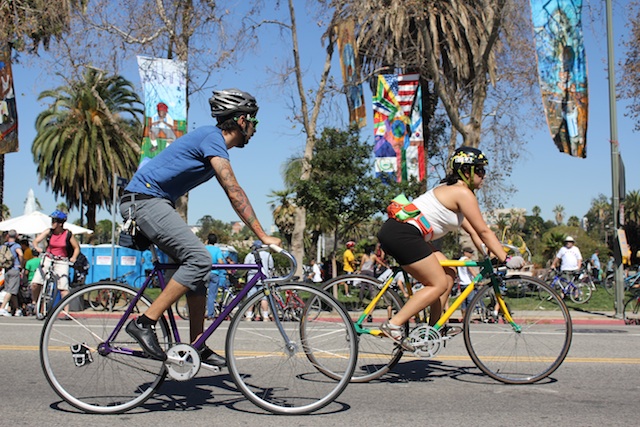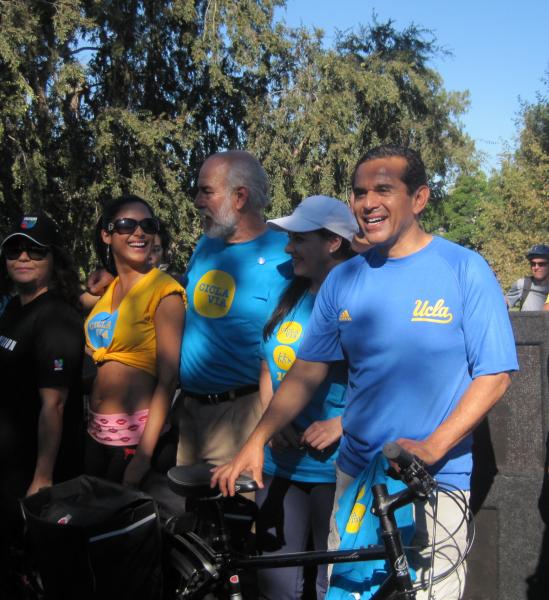Bicycles Take Over Streets Of LA During CicLAvia

Mayor Villaraigosa kicked off the event, called CicLAvia, with a speech in Hollenbeck Park in Boyle Heights, the end point for the 7.5 mile route. He then mounted his bike for the first time since his bike accident in mid-July, and headed out for a ride. Villaraigosa announced that he expected about 35,000 people to attend; that estimate was exceeded, according to CicLAvia representative Brad Rehak. An estimated 50,000 people participated in the event. "People think this started with a bike accident, but it didn't,” said Villaraigosa, referring to an incident in June in which he crashed and broke an arm after swerving to miss a taxicab while riding his bicycle. “It really started with a visit to Copenhagen and Mexico City."

The idea has spread across the globe, from Bogotá to Copenhagen, Mexico City, and beyond. Villaraigosa said, “if [Copenhagen and Mexico City] can do it, why not us? And particularly, why not here -- in the car capital of the United States."
Sunday’s event represented the fruition of over two years of planning to bring the international ciclovia phenomenon to Los Angeles.
The area surrounding the intersection of Melrose Avenue and Heliotrope Drive, known as the Bicycle District, buzzed with activity throughout the day.
Before the 10 a.m. start time, families and friends gathered with their bikes, making last minute adjustments and pumping up tires. The cloudless sky and complete absence of cars seemed to buoy the spirits of the riders.
Max Podemski, one of the organizing committee members for CicLaVia worked at a booth handing out maps of the routes and selling T-shirts printed with the event logo. Podemski was thrilled to see two years of hard work finally come to fruition. “It’s great that it’s a reality. Our goal is to have it like in Bogota and other cities where it’s a regular occurrence. We hope this is the first of many CicLAvias.”
One of his favorite aspects of the day is the collaboration between local businesses and non-profits. Homeboy Industries, a group that helps former gang members through job training and education, printed the shirts Podemski and other volunteers were selling. “This has been a real grass roots effort,” he said. “We partnered with the city, but really it’s been organized by volunteers. We’ve collaborated with Homeboy and the Bike Kitchen, the Centro Medico, so it’s really been a multi-group effort.”
Further up Heliotrope Drive, Woody Joseph set up a small stand to promote Bike Buckets, recycled four-gallon buckets that can attach to a bike and help to carry groceries or other items. He’s sold his buckets at Los Angeles County Bicycle Coalition events before, but this is the biggest bike crowd he’s seen. “I’m in it more for the bicycle advocacy, rather than just trying to become a bucket entrepreneur,” Joseph said.
Lots of children were present at this hub on the route, but Richelle and Jena, two moms who live close to the Bicycle District, decided to leave their kids at home and make it a girls’ day out. “So far, it’s been really nice,” Richelle said. “It’s nice to be able to bicycle along such an open road in LA, in the middle of downtown. I try to bike other times, but it’s scary, especially when there are cars parked along the curb and you’re not sure if someone is going to open their door or not.”
Richelle said that knowing the route would be car-free allowed her to really enjoy the ride and take in the scenery, rather than concentrating on not getting injured. Jena agreed, and liked that they could join the route at any place and go in either direction.
Iggy Cortes, who works at the bike shop Orange 20, liked that everyone seemed to be in a good mood and noticed that people were talking to each other more than usual. Cortes loves riding his bike in L.A. “With weather like this? Year round? What more could you ask for?”
Cortes liked his bike so much, that four years ago, he sold his car and has been automobile-free ever since. He said the transition from car to bike wasn’t too difficult and that he doesn’t feel like he’s given anything up. To those who think they could never part with their cars, Cortes offered words of encouragement. “You just gotta convince yourself. Take your time, and do it for a week. Do it for a couple of days, then do it for a few more days. Do it for two weeks, and so on, and before you know it, it’s no big deal.”
This story is part of a collaboration between Annenberg Radio News and Neon Tommy.



